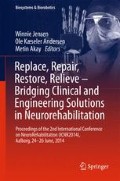Abstract
This paper describes a novel exoskeleton focusing on its parametrization and the redesign of the mechanical metacarpophalangeal joint with an integrated sensor. The joint is based on an arc structure with its rotation axis being aligned with the anatomical center of rotation. A Hall effect based linear encoder is integrated into the base-connected arc reading out a multi-pole magnetic strip in the moving arc. The accuracy was evaluated based on the tendon displacement measured by the motor encoder and converted into the respective angle with two different calculation methods. The parametrization adapts the exoskeleton to the patient’s hand size to avoid misalignment without the use of adaption mechanisms. The exoskeleton is parameterized to a stroke patient. The measurement process is described and evaluated, quantitatively, by comparing two data sets and, qualitatively, by examining the visual overlay of the model onto an image of the hand.
This work was supported by the Graduate School for Computing in Medicine and Life Sciences funded by Germanys Excellence Initiative (DFG GSC 235/1).
Access this chapter
Tax calculation will be finalised at checkout
Purchases are for personal use only
Preview
Unable to display preview. Download preview PDF.
References
Johnston, S.C., Mendis, S., Mathers, C.D.: Global variation in stroke burden and mortality: estimates from monitoring, surveillance, and modelling. The Lancet Neurology 8(4), 345–354 (2009)
Kwakkel, G., Kollen, B.J., van der Grond, J., Prevo, A.J.H.: Probability of regaining dexterity in the flaccid upper limb impact of severity of paresis and time since onset in acute stroke. Stroke 34, 2181–2186 (2003)
Woldag, H., Hummelsheim, H.: Evidence-based physiotherapeutic concepts for improving arm and hand function in stroke patients. Journal of Neurology 249(5), 518–528 (2002)
Kwakkel, G., Kollen, B.J., Krebs, H.I.: Effects of robot-assisted therapy on upper limb recovery after stroke: a systematic review. Neurorehabilitation and Neural Repair 22(2), 111–121 (2008)
Milot, M.-H., Spencer, S.J., Chan, V., Allington, J.P., Klein, J., Chou, C., Bobrow, J.E., Cramer, S.C., Reinkensmeyer, D.J.: A crossover pilot study evaluating the functional outcomes of two different types of robotic movement training in chronic stroke survivors using the arm exoskeleton bones. Journal of Neuroengineering and Rehabilitation 10(1), 112 (2013)
Maciejasz, P., Eschweiler, J., Gerlach-Hahn, K., Jansen-Toy, A., Leonhardt, S., et al.: A survey on robotic devices for upper limb rehabilitation. Journal of NeuroEngineering and Rehabilitation 11(1), 3 (2014)
Li, J., Wang, S., Wang, J., Zheng, R., Zhang, Y., Chen, Z.: Development of a hand exoskeleton system for index finger rehabilitation. Chinese Journal of Mechanical Engineering 25(2), 223–233 (2012)
Jones, C.L., Wang, F., Osswald, C., Kang, X., Sarkar, N., Kamper, D.G.: Control and kinematic performance analysis of an actuated finger exoskeleton for hand rehabilitation following stroke. In: 2010 3rd IEEE RAS and EMBS International Conference on Biomedical Robotics and Biomechatronics (BioRob), pp. 282–287. IEEE (2010)
Tong, K., Ho, S., Pang, P., Hu, X., Tam, W., Fung, K., Wei, X., Chen, P., Chen, M.: An intention driven hand functions task training robotic system. In: 2010 Annual International Conference of the IEEE Engineering in Medicine and Biology Society (EMBC), pp. 3406–3409. IEEE (2010)
Takahashi, C.D., Der-Yeghiaian, L., Le, V., Motiwala, R.R., Cramer, S.C.: Robot-based hand motor therapy after stroke. Brain 131(2), 425–437 (2008)
Burton, T.M.W., Vaidyanathan, R., Burgess, S.C., Turton, A.J., Melhuish, C.: Sensitivity analysis of a parametric hand exoskeleton designed to match natural human grasping motion. In: Herrmann, G., Studley, M., Pearson, M., Conn, A., Melhuish, C., Witkowski, M., Kim, J.-H., Vadakkepat, P. (eds.) TAROS-FIRA 2012. LNCS (LNAI), vol. 7429, pp. 390–401. Springer, Heidelberg (2012)
Weiss, P., Heyer, L., Münte, T.F., Heldmann, M., Schweikard, A., Maehle, E.: Towards a parameterizable exoskeleton for training of hand function after stroke. In: 2013 IEEE International Conference on Rehabilitation Robotics (ICORR). IEEE (2013)
Pooyania, S., Semenko, B.: Botulinum toxin type-a (bonta) and dynamic wrist-hand orthoses versus orthoses alone for the treatment of spastic-paretic upper extremity in chronic stroke patients. Open Journal of Therapy and Rehabilitation 2, 12 (2014)
Shuang, W., Jiting, L., Yuru, Z., Ju, W.: Active and passive control of an exoskeleton with cable transmission for hand rehabilitation. In: 2nd International Conference on Biomedical Engineering and Informatics, BMEI 2009, pp. 1–5. IEEE (2009)
Author information
Authors and Affiliations
Editor information
Editors and Affiliations
Rights and permissions
Copyright information
© 2014 Springer International Publishing Switzerland
About this paper
Cite this paper
Weiss, P., Männel, G., Münte, T., Schweikard, A., Maehle, E. (2014). Parametrization of an Exoskeleton for Robotic Stroke Rehabilitation. In: Jensen, W., Andersen, O., Akay, M. (eds) Replace, Repair, Restore, Relieve – Bridging Clinical and Engineering Solutions in Neurorehabilitation. Biosystems & Biorobotics, vol 7. Springer, Cham. https://doi.org/10.1007/978-3-319-08072-7_114
Download citation
DOI: https://doi.org/10.1007/978-3-319-08072-7_114
Publisher Name: Springer, Cham
Print ISBN: 978-3-319-08071-0
Online ISBN: 978-3-319-08072-7
eBook Packages: EngineeringEngineering (R0)

